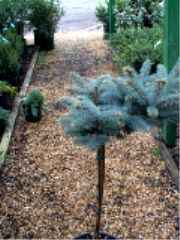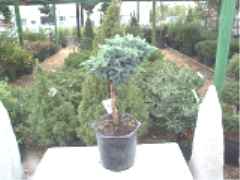 |
|
 |
 |
|
 |
The search for outstanding specimens often lead us to "standards" which encompasses interesting materials grown on a single trunk of limited height. I have a Delaware Valley azalea in a large terra cotta dish which I standardized in 1981. It has lived in 7 different houses since I stated the plant. I considered bonsai for this plant until further study told me of daily waterings needed to sustain the tiny root system. As it is, I simply water the plant about once a month if things have been dry. This azalea has been to Death's door and back. We have a special relationship, as its needs are few.
Topiary is the art of shaping plants through pruning. "Standardizing" involves developing a plant on the top of a single trunk. This is often done by grafting a species of plant on to a straight truck of another species, thus yielding a vigorous root system. More commonly, a single trunk is selected and staked, and the laterals are trimmed of as the plant gains height. One could standardize a plant by doing the trimming at maturity, though it is unlikely that a perfectly straight trunk will be available. In all cases, the height of the standard is limited to the most terminal (tip) growth of the plant. Once the top has been trimmed out, the plant will probably grow from this tip into a rounded formation.
Most standards tend to be very hardy. They work well as a punctuation plant on a corner or by the door. Evergreens lend themselves to year round interest. The standards are also generally very good container plants. The heights range from 12 inches tall to 8 feet tall. Most are 24 to 36 inches tall. My azalea is 24 inches tall. Their greatest attribute is their ability to fill a small area and stay within its confines for the duration.
I have seen many non standardized Dwarf Alberta Spruces live and die, while a simple standardized Blue Spruce has outlived them all. Other standards include roses, azaleas, junipers, weeping cherries, mulberries, and contorted filberts (good old "Harry Lauder's Walking Stick"). My Delaware Valley azalea was started from a $2.00 azalea in a one gallon pot. I simply spotted a "leggy" plant with 7 main trunks. I removed 6, retaining the straightest trunk. I then inserted a 10 cent bamboo stake into the pot and used twist ties to attach the stem to the stake. The plant now has a trunk about one inch in diameter and a head about 30" in diameter.
Most "standards" will cost more than your average shrub. However, "leggy" plants can often be bought for a reduced price should you choose to do your own thing. While one would probably never buy a dozen of these plants for a hedge, they are certainly a nice addition to any plan. They provide beauty and fill specials niches. Until next week.
Andy Lynn